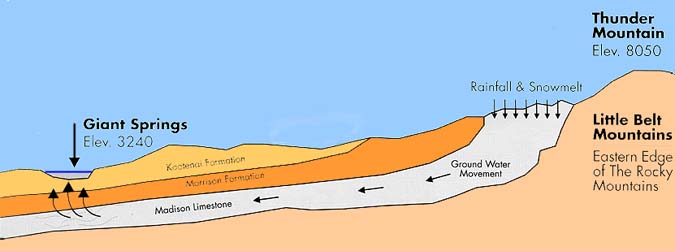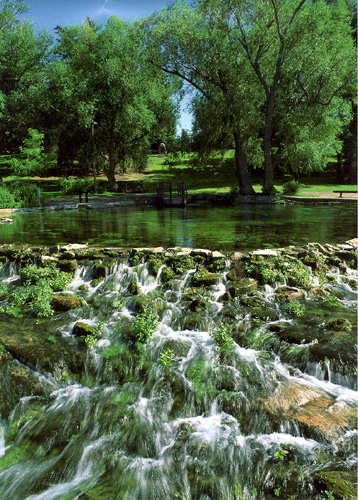|
An "Artesian"
Situation 
Photo and diagram
courtesy of Giant Springs Bottled Water
Company 
Pure and pleasant . . .
During
the Lewis and Clark Expedition in 1805,
Merriwether Lewis wrote, “I think this fountain
the largest I ever beheld, extremely
transparent and cold, very pure and pleasant”.
Lewis was referring to a place called Giant
Springs where water comes out of the ground
along the Missouri River on the northern edge
of Great Falls. Nearly 200 million gallons of
water per day come out of the springs and
then flow into the Missouri River some 201
feet away. Called the Roe River, this flow is
arguably the shortest river in the USA.
Three Requirements . . .
The diagram at the top of this page shows
the artesian nature of the aquifer that brings
the water to Giant Springs. The word
“artesian” indicates that the water is forced to
the surface by hydrostatic pressure (without
pumping). For this to happen, three
conditions must be present. For one, the
aquifer must be sandwiched between
impermeable layers (layers that won't let water soak in). In the case of Giant
Springs, the aquifer is a layer called the
Madison Limestone. It lets water enter and
pass through it, whereas the layers of rock
above and below it do not. A second
requirement is that the aquifer must be sloped
as the Madison Limestone is between the
Little Belt Mountains and Great Falls. Finally,
the spring (or well) must be at an elevation
that is lower than the elevation of the recharge
area. This is also true with Giant Springs. Its
waters originate as precipitation that falls on
the Little Belt Mountains over 4,000 feet above
the Missouri River. At Giant Springs
pressure forces water up from a
depth of 700 feet through cracks in the rock
layers above the limestone. The water emerges at Giant Springs, some 40 miles away from the recharge area in the Little Belt Mountains where it fell as precipitation. Several years ago, scientists used radiocarbon dating to determine the age of trace amounts of carbon contained in the water to determine that the water takes 2,900 years to travel from the mountains to the river. The results were later found to be invalid.
NOTE: Giant Springs State Park is a short
walk from the Lewis and Clark Interpretive
Center.
Terms: recharge area, impermeable
| 




